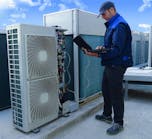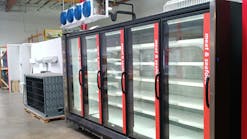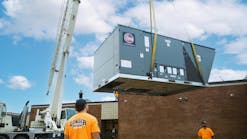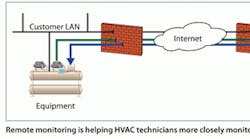Chillers often represent a plant's single largest electric load. But factor in fouled tubes, leaking refrigerant, or myriad other factors, and operating costs can quickly escalate by eight to 10%. Operating chillers at their peak performance will save energy and maintenance costs.
Chiller maintenance has advanced significantly, due to new developments in centrifugal chillers with magnetic bearing chillers, and new remote monitoring technologies. As a result of remote monitoring, the industry has been moving toward demand maintenance programs and away from pre-determined schedule maintenance.
Whichever program you use, here are 10 maintenance tips that apply to most centrifugal chillers, to help maintain high efficiency:
Keep a daily log
The daily log is still the first step toward maintaining an efficiently-run chiller plant. The log allows you to build a history of operating conditions including temperatures, pressures, fluid levels, and flow rates. Remote monitoring technologies allow you to inspect machines continually rather than monthly or every other month. And, it allows you to easily generate trend reports that help to identify maintenance needs before they become an issue.
Keep tubes clean for efficient heat transfer
Heat transfer efficiency has the greatest single effect on chiller performance, so clean heat transfer is fundamental to maintaining high efficiency. Contaminants such as minerals, scale, mud, algae and other impurities increase thermal resistance and reduce overall performance. Approach temperatures are a good indicator of heat transfer efficiency. Higher approach temperatures are prime indicators that heat transfer efficiency is decreasing. Condenser tubes should be brush cleaned at least annually, or per your demand maintenance schedule to keep them free of contaminants.
Treat condenser water to prevent scale, corrosion
All condenser water loops using open cooling sources (such as atmospheric cooling towers) require water treatment of some sort to eliminate scale, corrosion and biological growth. All lead to fouling in the condensers and impede heat transfer and can decrease tube and piping effectiveness. Inspect chilled water loops once a year or regularly with remote monitoring for general water quality and evidence of corrosion.
Lower entering water temperature
Lowering the temperature of the entering condenser water will improve the chiller's efficiency. On some building systems, the operator will lower the chilled water set point to overcome air handler deficiencies such as dirty coils. This cures the symptom but not the problem, and makes the chiller work harder for the same net cooling effect.
Keep chilled water flow rate between 3 to 12-ft per second
Changing the chilled water flow rate affects a chiller's performance. Too low a flow rate lowers the chiller efficiency and ultimately leads to laminar flow. The minimum flow rate is typically around 3-ft. per second (FPS). Too high a flow rate leads to vibration, noise, and tube erosion. The maximum recommended flow rate is typically around 12 FPS.
Maintain adequate refrigerant charge
The actual amount of cooling a chiller provides depends on how much refrigerant it moves through the compressor. It is important to maintain the proper level of refrigerant for the conditions desired. Refrigerant leaks, as well as air and moisture introduced into the system, will decrease efficiency and the reliability of the system. A low refrigerant charge will cause the compressor to work harder for less cooling effect.
Prevent inefficiencies caused by non-condensables
Non-condensables such as air and moisture leak into low pressure chillers because their evaporators operate in a vacuum. Non-condensables can lower the real efficiency of the chiller from the rated performance by as much as 4% at 60% load and 7% at 100% load. Purge units minimize the effect of non-condensables.
Analyze compressor oil
Send a sample of the lubrication oil to a laboratory for a “spectrometric” chemical analysis once a year. Like any hermetically sealed refrigeration system, the oil should only be replaced if the analysis indicates it's needed. High moisture can indicate a problem with the purge unit. Sample low pressure chillers more frequently, based on purge run hours. Check oil filters for pressure drop and replace them if the oil charge is replaced. New, magnetic bearing frictionless chillers require distinctly different maintenance and operations from traditional centrifugal chillers. Oil has been eliminated in the design of these chiller systems, further reducing maintenance costs.
Check operation of starters and motors
For efficient operation of starters and motors, check the safety and sensor calibrations on microprocessor controls (consult manufacturer's guidelines). Then, check electrical connections, wiring, and switchgear related to the chiller for hot spots and worn contacts. To prevent insulation faults, test electrical motor windings for insulation resistance to ground and winding-to-winding. Check the shaft seal of open drive motors for possible refrigerant leaks, and clean motor cooling air vents to ensure maximum cooling effect.
Install variable speed drives
The chiller motor is typically the largest single electrical load in a building. With the right operating conditions, variable speed drives (VSD) can offer significant energy savings. Varying motor speed matches motor efficiency to load and wastes less energy. Variable speed drives also act as a soft starter to lower the inrush current for the motor to almost that of the full load running amps. This is an important factor for chillers operating on emergency power generators.
VSDs reduce the mechanical shock of starting large horsepower motors, increasing chiller reliability, and life.
Richard Grenz is national service sales manager for McQuay International's, Field Service Division.









